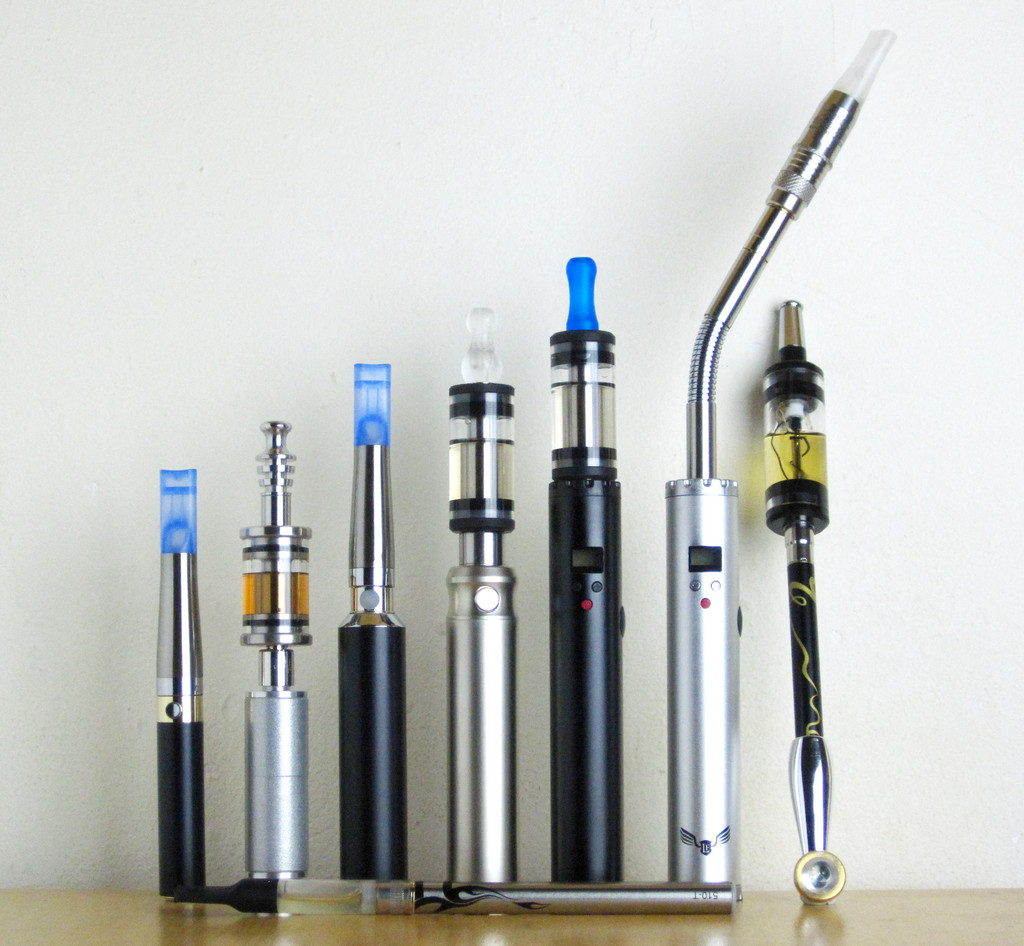
This post was published when Public Health England had responsibility for health advice relating to e-cigarettes. For the most recent information please visit the NHS website or search for the topic on the gov.uk website.
What role can e-cigarettes play in tobacco control?
This is a complex question to answer, but it’s precisely because it’s complex that Public Health England needs to set out its position, informed by the best evidence we have to date.
This is an issue that has always had the potential to stir up controversy, and recent weeks have been no exception. However, alongside a number of key partners, including the Association of Directors of Public Health, Faculty of Public Health, Royal Society for Public Health and Cancer Research UK, I’m delighted that a public health consensus on e-cigarettes has begun to emerge.
In this blog I outline some broad principles which underpin our work in PHE and provide a guide to our future work in this area.
1. We believe in a comprehensive tobacco strategy
Adult smoking rates in England have fallen by a third in the last 20 years and by more than two thirds among children. However there is no room for complacency and we welcome the recent commitment by ministers to develop an updated tobacco control strategy for England.
This new strategy will build upon our current world-leading, comprehensive tobacco control programme, which focuses on helping smokers to quit, preventing uptake of smoking and protecting people from the harm of secondhand smoke.
We also have the support of a strong legislative framework which will see over the coming months the ending of smoking in cars with children present, prohibitions on the sale of e-cigarettes to under-18s and on the purchase by adults of tobacco and e-cigarettes for under-18s, and the introduction of standardised packaging of tobacco products.
Our commitment to each of these is demonstrable and unwavering.
We think e-cigarettes have a role to play in the future of our tobacco control programme. First, because there are already 2.6 million adults using them in Britain. These users are almost entirely either current smokers (3 in 5) or ex-smokers who have switched to vaping and stopped smoking completely (2 in 5).
The second reason is that e-cigarettes are now the most popular quitting aid (far more popular than local stop smoking services or licensed medications)
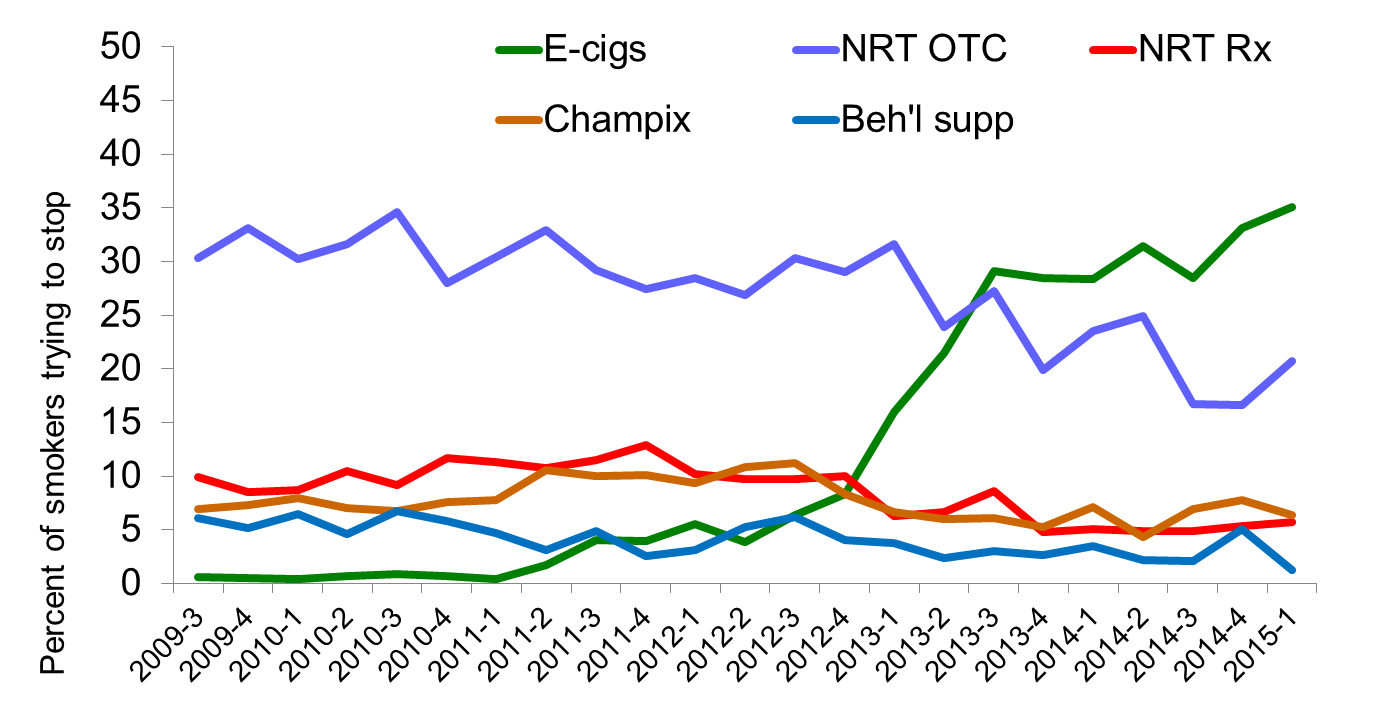
Smoking in England Toolkit
And third, because we can already see that in local stop smoking services they work well. While the number of smokers using an e-cigarette alongside expert support is small – around 13,000 in 2014-15 – of those, over 8,000 quit successfully (a 65% success rate).
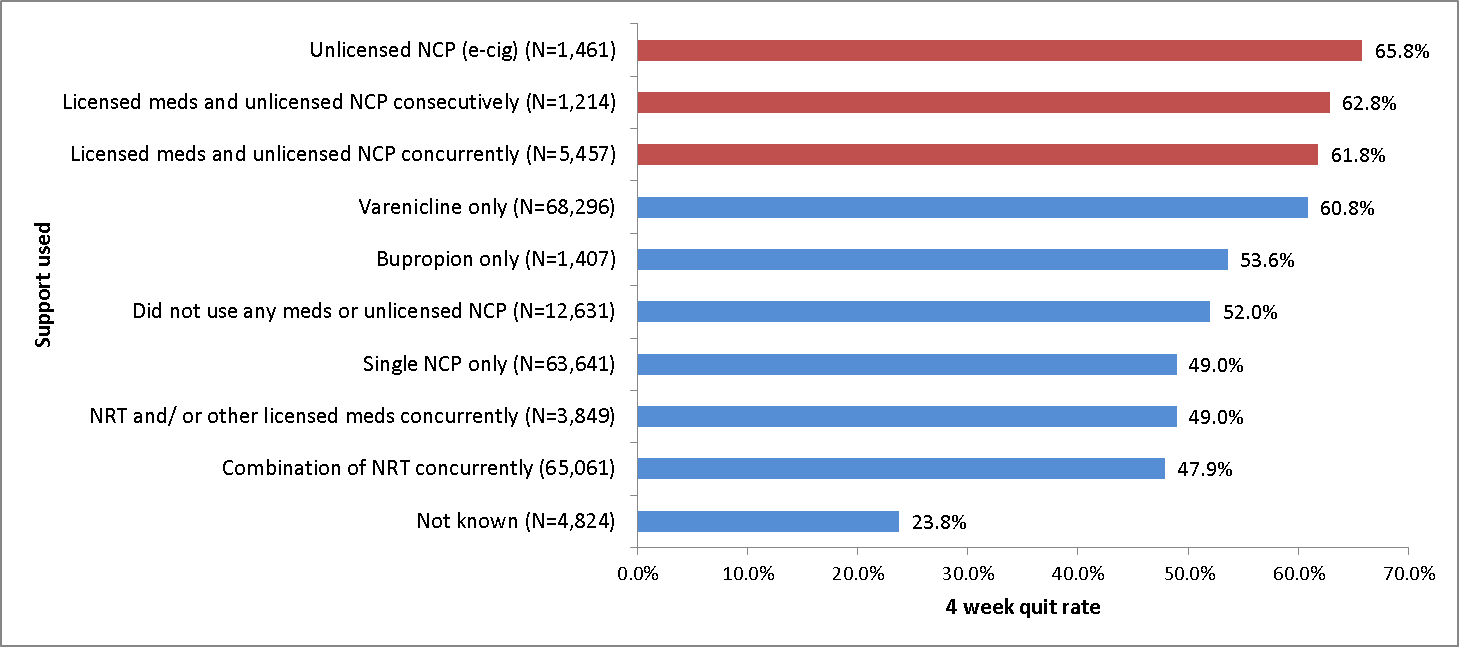
Source: Taken from Health and Social Care Information Centre. Statistics on NHS Stop Smoking Services in England - April 2014 to March 2015.Publication date: August 19, 2015. http://www.hscic.gov.uk/catalogue/PUB18002/stat-stop-smok-serv-eng-annual-1415.xlsx
But let’s be clear: we’re not telling smokers how to quit. We’re just setting out the range of options that smokers have and describing their relative effectiveness.
Our advice on this hasn’t changed. Smokers who want to quit are more likely to succeed if they use local stop smoking services: these are up to four times more effective than trying to stop with no help.
Yet, over 50% of smokers who are trying to quit report using methods with the least evidence of effectiveness. We want to combine the most popular approach with the most effective one.
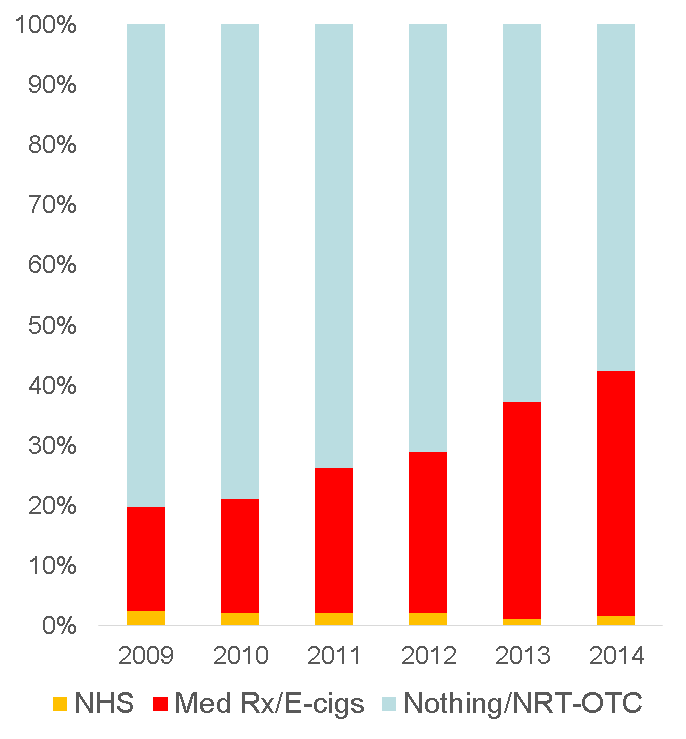
www.smokinginengland.info/latest-statistics
It is simply not viable for a national public health agency to ignore the millions of smokers who have used or are using e-cigarettes to quit smoking.
2. E-cigarettes are not risk free
E-cigarettes are not 100% safe. We have been wrongly criticised for suggesting they are, but PHE has always been explicit about this.
The authors of PHE’s latest independent evidence review, published last month, have said quite clearly that some flavourings and components in e-cigarettes may pose risks over the long term.
However, most of the constituents of cigarette smoke that harm health are absent in e-cigarette vapour. Even when these chemicals are present, they are mostly at levels far below those in tobacco smoke, below 5%, and often as low as 100th or 1000th.
Meanwhile, the main chemicals present in e-cigarettes only are not associated with any serious risk to health.
So, all of the evidence suggests that the health risks posed by e-cigarettes are relatively small by comparison, but we must continue to study the long term effects. PHE is committed to supporting this ongoing monitoring and research through our partnerships with academics and local implementers.
3. Consumers and the public deserve protection from potential harms
If the risks of vaping were to prove as high as 5% of the risk of smoking that is a big step down for smokers, but a very sizeable increase in risk for non-smokers.
That is why we don’t want non-smokers, especially young people, to start vaping. On 1 October 2015, regulations to protect children will make it an offence to sell e-cigarettes to anyone under 18 or to buy e-cigarettes for them.
Within a year, the EU Tobacco Products Directive proposes a ban on all print and broadcast advertising of non-medicinally regulated e-cigarettes as part of a full range of regulations.
We look forward to the advent of some e-cigarettes available as licensed medicines that will provide quitters with a wider choice of clinically proven, safe and effective products. Medicinally licensed e-cigarettes will also provide clinicians with a new prescribing option, especially for smokers who are struggling to quit for good.
Ultimately, we want to see a thriving market of both high quality consumer and medicinally regulated products, supported by access to strong local stop smoking services, which gives smokers a real choice of products to help them quit.
4. Smokers should be told that stopping is the best thing they can do for their health
There is no circumstance in which it is better for a smoker to continue smoking tobacco. This is an addiction that kills one in every two lifelong smokers, and remains the number one killer in England. There are nearly 80,000 smoking-related deaths a year and smoking costs the NHS about £2bn a year.
PHE’s message to smokers continues to be that we want to help them quit tobacco completely and forever. Our advice to smokers who have already tried and failed in the past is to consider vaping - and then stop smoking. 1.1 million smokers in Britain already have done so with an e-cigarette.
5. Ongoing surveillance and research is crucial to detect long-term impacts on individuals and communities
PHE is committed to the highest standards of research and evidence. That’s why our statements about e-cigarettes are always accompanied with the necessary call for ongoing monitoring, surveillance and research. And that is why we have joined with Cancer Research UK, to set up the UK E-cigarette Research Forum.
If any new risks emerge, of course we will revise our recommendations to smokers and regulators. In the meantime we have a vital responsibility to communicate the evidence that is emerging and currently, we believe, it is sufficiently robust to help guide us.
One such piece of evidence is that the big increase in e-cigarette use over the past five years has not led to an increase in smoking rates. In fact, as e-cigarette use has increased, smoking rates among young people and adults have continued to fall.
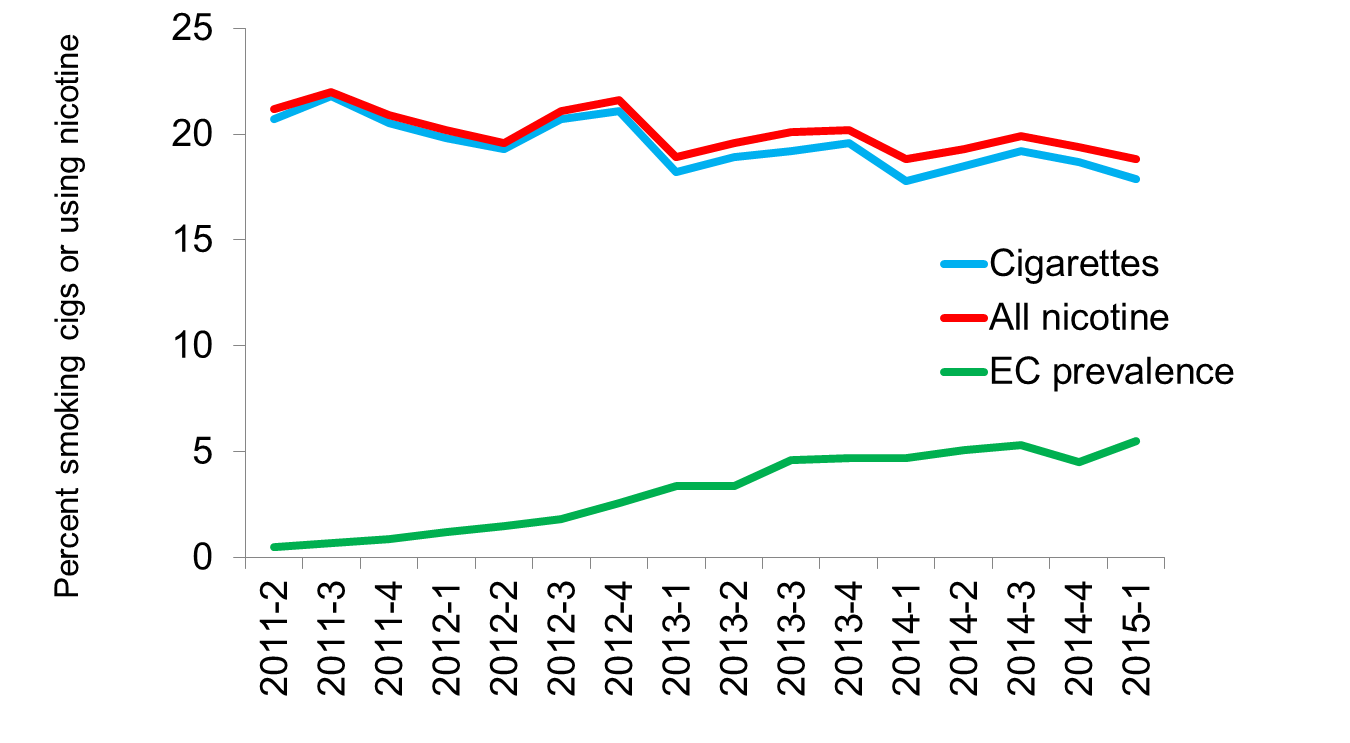
We don’t believe the data that we have so far justify fears that e-cigarettes act as a route into smoking or renormalise tobacco use. But we cannot be complacent and continued vigilance in this area is essential and we will monitor the data closely.
6. We need clear and consistent messages to the public
There is widespread public confusion about e-cigarettes and research shows people’s perceptions have become less accurate.
All the evidence tells us e-cigarettes are less harmful than tobacco but a growing number believe e-cigarettes are at least as harmful or say they don’t know. This matters because this inaccurate view is worryingly common among those smokers who have never tried e-cigarettes and it would be a terrible thing if these false perceptions scared smokers out of quitting.
We have a duty to provide clear messages to the public. We’re helping to fulfil our mission by stating what we know based on the evidence.
That is: e-cigarettes carry a fraction of the risk of smoking and can help even some of the most addicted smokers to quit and smokers who switch to vaping reduce the risks to their health dramatically.
Some people quit smoking overnight; some people take a little longer and require more support. For every smoker trying to quit, PHE backs them every step of the way.
What next?
In summary, PHE has taken a pragmatic and evidence-based approach to responding to the challenge and opportunity of e-cigarettes.
We do this within the context of a strong national tobacco control programme; a growing understanding of the prevalence and patterns of use of e-cigarettes; a desire to accelerate tobacco control efforts which include harm reduction for smokers and protecting our youth; and a commitment to monitoring the medium and long term effects of e-cigarettes.
We recognise that the evidence continues to evolve and will continue to review and update our guidance as necessary, ensuring that we provide space for evidence-based debate and discussion on this and any other emerging issue.
A key priority for us will be to move from evidence into action particularly:
- Supporting local stop smoking services to work with vapers to help them to quit smoking for good
- Ensuring that clear and consistent messages are available to the public
- Supporting local authorities and employers on principles to guide decision making on indoor vaping policies
- Working with academics to identify priorities for research in the near and medium term.
Key to the success of this approach will be close collaboration with policy makers, programme implementers, the public health community, academics, and members of the public. We all have a shared ambition to eliminate the harm from tobacco and to work towards a smokefree generation. This remains resolutely at the forefront of our collective efforts.

4 comments
Comment by Jill Baldwin posted on
I am so pleased to see PHE backing electronic cigarettes. I had to give up smoking for health reasons after being on up to 60 cigarettes a day. I tried NRT through my GP's smoking cessation nurse but after trying various ones over 9 months I just could not quit. My specialist gastroenterology nurse advised I take a break from trying to quit as my stress levels were rising too much. A month later I saw disposible cigarettes in my local supermarket at the tobacco kiosk. I bought was and was pleasantly surprised. I researched e-cigarettes on line as there were no specialist shops then. I bought a set up and smoked my last cigarette at about noon on 13th January 2012, started vaping immediately after and never looked back. No withdrawal symptoms, breathing improved, taste and smell as well. Still vaping but my nicotine has gone down from 18mg/ml to 6mg/ml. I will continue vaping as long as it is available but know that if I couldn't get my favourite e-liquids (mainly strawberry yoghurt flavour atm) it would be so easy to pick up a cigarette. Done it once when I had run out e-liquid, had to buy a packet of 10 and smoked through them all before I realised. Now I carry spare with me so that this doesn't happen ever again.
Comment by Stuart Turner posted on
What will be happening once the TPD is implemented and the most effective ecigs (generation 2 and 3) are effectively banned from the market?
How will PHE handle this situation? a large portion of current and potential vapers will be locked out of the market and jobs will be lost.
Comment by Adrian shepherd posted on
Thankyou for a very balanced & unbiased report on e cigarettes, vaping & the health effects in general
Comment by Joe Penovich posted on
PHE seem to be the only sane government body in the world!
https://www.vapetrotter.com/news/evidence-review-e-cigarettes-heated-tobacco-products-2018-public-health-england-released/